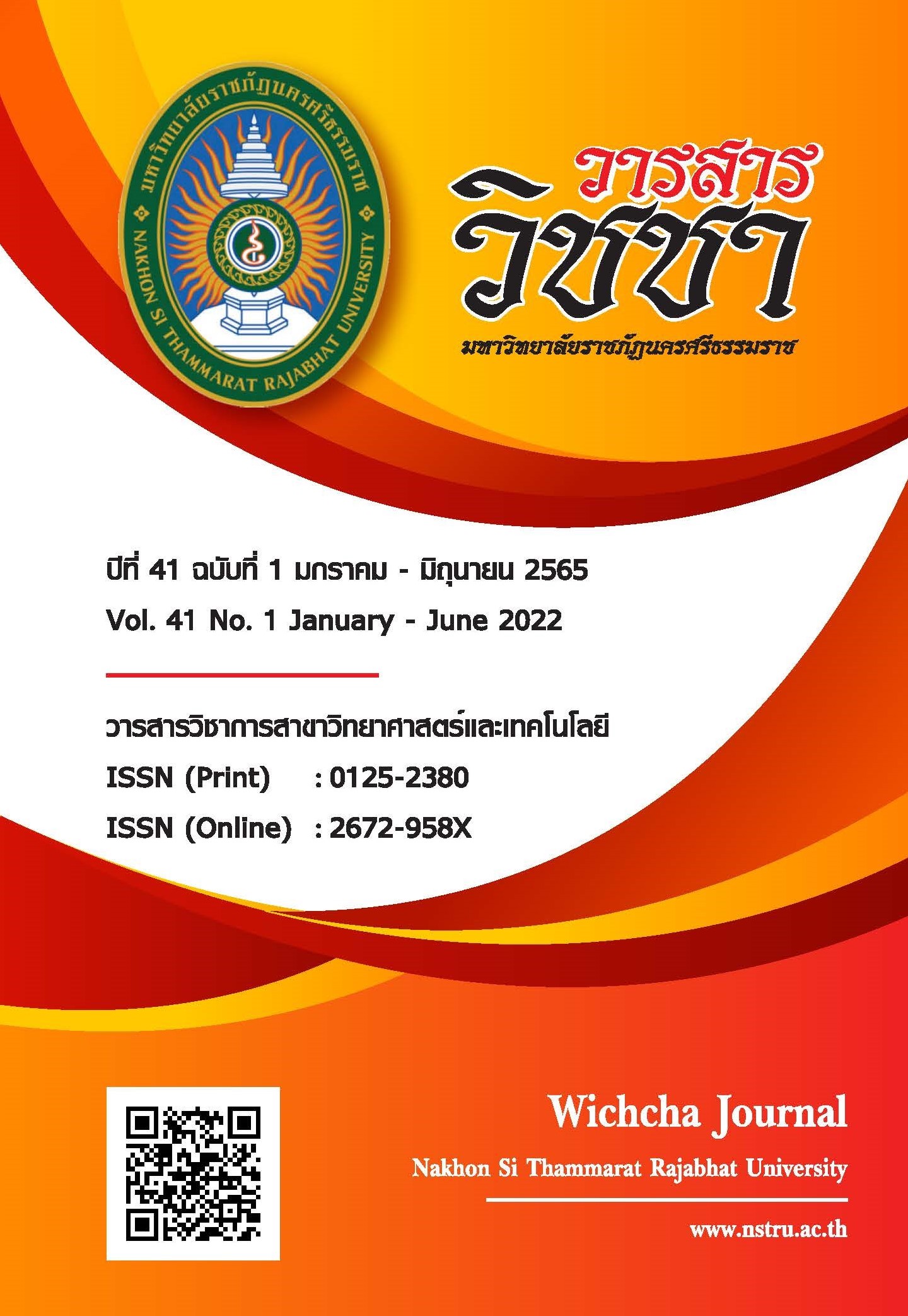Effect of Selenium Supplemented Hom Thong Banana Tree Compost on Growth, Yield, and Selenium Content of Lettuce
Main Article Content
Abstract
The lettuce was grown by using planting soil in combination with selenium supplemented Hom Thong Banana tree compost at Thailand Institute of Scientific and Technological Research (TISTR). The experiment was arranged in a randomized complete block design (RCBD) consisting of 4 planting materials with 3 replications; planting soil (control), planting soil with 0, 450 and 675 ppm selenium supplemented Hom Thong banana tree compost (1st, 2nd and 3rd compost recipes, respectively). Growth, yield, and selenium content in lettuce were recorded at 28 days after transplanting. The results showed that planting soil with 2nd compost recipe gave the highest height, leaf width, number of leaves, fresh and dry weight at 15.51 cm, 8.55 cm, 8.00 leaves, 27.06 g and 1.40 g, respectively. Planting soil with 3rd compost recipe gave the highest leaf length, leaf greenness and canopy width at 10.01 cm, 26.54 SPAD Unit and 17.36 cm, respectively. Moreover, planting soil with 3rd compost recipe gave the highest accumulation of selenium in lettuce at 321.08 ug/kg. Therefore, planting soil with the 2nd compost recipe was the most suitable planting material for lettuce with a high yield and selenium content.
Article Details

This work is licensed under a Creative Commons Attribution-NonCommercial-NoDerivatives 4.0 International License.
เนื้อหาและข้อมูลในบทความที่ลงตีพิมพ์ในวารสารวิชชา มหาวิทยาลัยราชภัฏนครศรีธรรมราช ถือเป็นข้อคิดเห็นและความรับผิดชอบของผู้เขียนบทความโดยตรง ซึ่งกองบรรณาธิการวารสารไม่จำเป็นต้องเห็นด้วยหรือร่วมรับผิดชอบใด ๆ
บทความ ข้อมูล เนื้อหา รูปภาพ ฯลฯ ที่ได้รับการตีพิมพ์ในวารสารวิชชา มหาวิทยาลัยราชภัฏนครศรีธรรมราช ถือเป็นลิขสิทธ์ของวารสารวิชชา มหาวิทยาลัยราชภัฏนครศรีธรรมราช หากบุคคลหรือหน่วยงานใดต้องการนำข้อมูลทั้งหมดหรือส่วนหนึ่งส่วนใดไปเผยแพร่ต่อหรือเพื่อการกระทำการใด ๆ จะต้องได้รับอนุญาตเป็นลายลักษณ์อักษรจากวารสารวิชชา มหาวิทยาลัยราชภัฏนครศรีธรรมราชก่อนเท่านั้น
The content and information in the article published in Wichcha journal Nakhon Si Thammarat Rajabhat University, It is the opinion and responsibility of the author of the article. The editorial journals do not need to agree. Or share any responsibility.
References
ครองใจ โสมรักษ์. (2560). ผลของปุ๋ยหมักกากครามต่อการเจริญเติบโตและผลผลิตของคะน้า. วารสารเกษตรพระวรุณ, 14(2), 165-172.
ธนภัทร ปลื้มพวก จันทร์จรัส วีรสาร อรุณศิริ กำลัง และธงชัย มาลา. (2558). การปนเปื้อนแคดเมียมในดินและการสะสมในผลผลิตข้าวบนพื้นที่ตำบลแม่ตาวและตำบลพระธาตุผาแดง อำเภอแม่สอด จังหวัดตาก. วารสารเกษตรพระวรุณ, 12(1), 1-8.
นิพนธ์ ไชยมงคล. (2562). สลัด/ผักกาดหอม. สืบค้นเมื่อ 12 เมษายน 2564, จาก: https://vegetweb.com/wp-content/download/let.pdf.
พงษ์นาถ นาถวรานันต์. (2563). อิทธิพลของปุ๋ยไนโตรเจนต่อปริมาณธาตุอาหารในดิน ปริมาณธาตุอาหารในใบ และการติดผลของส้มโอพันธุ์ทองดี. วารสารวิชชา มหาวิทยาลัยราชภัฏนครศรีธรรมราช, 39(2), 16-30.
พัชรี เดชเลย์ คมกฤษณ์ แสงเงิน อนันต์ พิริยะภัทรกิจ และณัฐพงค์ จันจุฬา. (2564). คุณสมบัติของปุ๋ยหมักจากต้นกล้วยหอมทองเสริมซีลีเนียม. ใน การประชุมทางวิชาการของมหาวิทยาลัย เกษตรศาสตร์ ครั้งที่ 59 (หน้า 187-195). กรุงเทพฯ: มหาวิทยาลัยเกษตรศาสตร์.
ภัทร์ลดา สุธรรมวงศ์ พนิดา อติเวทิน อภิเดช แสงดี และวรัญญู แก้วดวงตา. (2553). อิทธิพลของซีลีเนียมต่อรูปแบบแสดงออกของโปรตีนในถั่วเขียว. วารสารวิทยาศาสตร์เกษตร, 41(3/1)(พิเศษ), 93-96.
อาณัติ จันทร์ถิระติกุล สุมาลี ชูกำแพง จันทร์ถิระติกุล และวิชญ์พล โถสายคำ. (2561). การผลิตผักกาดเขียวงอกและต้นแมงลักงอกซีลีเนียมสูงในระบบไร้ดิน. วารสารแก่นเกษตร, 46(พิเศษ 1), 1217-1223.
Ellis, D.R. and Salt, D.E. (2003). Plants, selenium and human heath. Current Opinion in Plant Biology, 6(3), 273-279, doi: https://doi.org/10.1016/s1369-5266(03)00030-x.
Feist, L.J. and Parker, D.R. (2001). Ecotypic variation in selenium accumulation among populations of Stanleya pinnata. New Phytologist, 149(1), 61-69, doi: https://doi.org/10.1046/j.1469-8137.2001.00004.x.
Fisinin, V.I., Papazyan, T.T. and Surai, P.F. (2008). Producing specialist poultry products to meet human nutrition requirements: Selenium enriched eggs. World's Poultry Science Journal, 64(1), 85-98, doi: https://doi.org/10.1017/S0043933907001742.
Kapolna, E. and Fodor, P. (2006). Speciation analysis of selenium enriched green onions (Allium fistulosum) by HPLC-ICP-MS. Microchemical Journal, 84(1-2), 56-62, doi: https://doi.org/10.1016/j.microc.2006.04.014.
Mounicou, S., Meija, J. and Caruso, J. (2004). Preliminary studies on selenium-containing proteins in Brassica juncea by size exclusion chromatography and fast protein liquid chromatography coupled to ICP-MS. Analyst, 129(2), 116-123, doi: https://doi.org/10.1039/b312960h.
Seppänen, M.M., Kontturi, J., Heras L.I., Madrid, Y., Cámara, C. and Hartikainen, H. (2010). Agronomic biofortification of Brassica with selenium-enrichment of SeMet and its identification in Brassica seeds and meal. Plant and Soil, 337, 273-283, doi: https://doi.org/10.1007/s11104-010-0523-y.
Terry, N., Zayed, A.M., De Souza, M.P. and Tarun, A.S. (2000). Selenium in higher plants. Annual Review of Plant Physiology and Plant Molecular Biology, 51, 401-432, doi: https://doi.org/10.1146/annurev.arplant.51.1.401.


